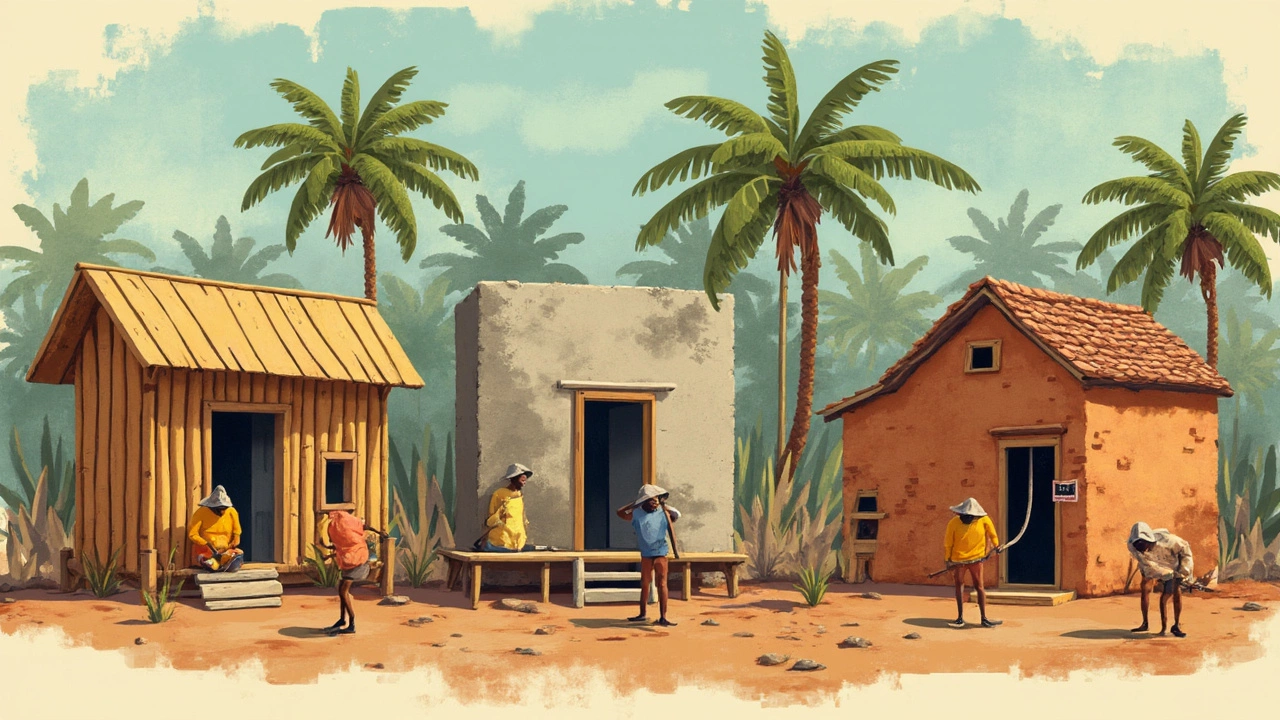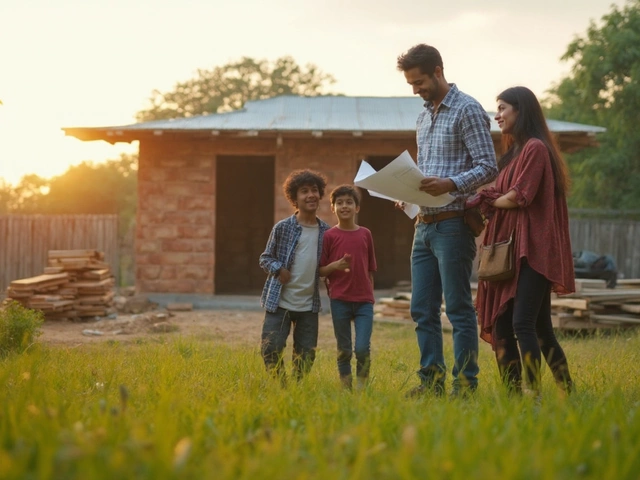Ever wondered if there’s a way to build a house without draining your savings or selling off anything that’s not nailed down? The truth is, some home designs are way easier on your wallet than most people think. Right now, it’s not about sprawling custom mansions or fancy architecture—instead, the cheapest homes are simple, compact, and use clever materials.
If you’re hunting for the absolute best bang for your buck, you’ll want to look at small, single-story homes like modular and prefab builds, stick-frame tiny houses, or some container homes. These aren’t just Pinterest trends—they’re being built by regular people who just need a solid, affordable roof over their heads. The cost difference compared to a standard house can easily run into the tens of thousands—sometimes more.
But don’t just chase what looks cheap on paper. There’s a lot to juggle: land prices, permits, utility hookups, and sneaky costs that pop up along the way. Let’s lay out the options, cut through the buzzwords, and put real numbers and smart tips in your hands so you get a house you can actually afford and enjoy.
- Cheapest Types of Homes to Build Today
- Breakdown of Home Building Costs
- Smart Tips to Save During Construction
- Beyond Price: What to Watch Out For
Cheapest Types of Homes to Build Today
If you’re trying to keep your new build on a tight budget, knowing your options is half the battle. Let’s break it down by the types of homes that offer the lowest upfront costs and fastest build times in 2025.
- Modular and Prefab Homes: Built in factories in sections and then assembled on-site. They use fewer materials and take way less time to finish than traditional stick builds. These homes often cut construction time in half, which means you save on labor costs. In many parts of the US, you can get into a simple prefab home for around $120 to $170 per square foot.
- Shipping Container Homes: These homes use recycled cargo containers as their structure. You can stack them, cut them, or arrange them a bunch of ways to make living spaces. They’re especially popular for small builds—think 320 to 960 square feet. On average, these can cost between $100 and $150 per square foot, not counting major customizations or land costs.
- Tiny Houses: These stick-built small homes focus only on essentials. They’re typically under 400 square feet. Materials are cheaper because you're using less of everything, from plumbing to insulation. Finished tiny homes often range from $60,000 to $100,000 (all-in, not just a shell).
- Basic Stick-Built Ranch Homes: Believe it or not, some old-school methods are still affordable. A simple, single-story, rectangular home with a basic roofline, no basement, and standard finishes still comes out cheaper than fancier designs. These usually run $120 to $180 per square foot.
Here’s a quick comparison of the numbers you might see in the real world, not counting land, utility hookup, or permitting:
| Type | Average Cost per sq ft | Typical Size | Example Total Price |
|---|---|---|---|
| Modular/Prefab | $120-$170 | 1,000-2,000 sq ft | $150k-$280k |
| Shipping Container | $100-$150 | 320-960 sq ft | $45k-$140k |
| Tiny House | (all in) | 150-400 sq ft | $60k-$100k |
| Basic Stick-Built Ranch | $120-$180 | 1,200-2,000 sq ft | $150k-$300k |
The cheapest home for you depends on your space needs and if you’re open to downsizing. If you’re handy or have friends in skilled trades, building something like a modular kit or a small stick-built ranch can save you more. Just keep in mind, these numbers don’t include land, utility hookups, or finishing touches you might want, like fancy counters or patios. That’s where budgets can spiral if you’re not careful.
Breakdown of Home Building Costs
When folks start dreaming about a new build, they usually think only about the big stuff—like lumber and bricks. But building even the cheapest home means stacking up costs you might not expect. On average, in the U.S. right now, the lowest-cost new builds (think tiny homes, prefab cottages, or basic modulars) run from $60,000 to about $150,000. That doesn't include your land, just the actual home.
The main costs stack up like this:
- Materials: What you build with makes a massive difference. Basic stick-frame builds (the classic wood frame) usually cost less than fancy concrete or steel, and they're homeowner-friendly if you want to swing a hammer yourself.
- Labor: If you’re hiring out, labor is likely the biggest single chunk. Modular or prefab homes lower labor costs a ton since a lot of the work happens in a factory.
- Permits & Inspections: These are required, and the cost really depends on your county or town. Some places charge a few hundred bucks, others closer to $5,000 or more.
- Site Prep: Clearing trees, leveling dirt, digging for utilities—these aren’t glamorous, but you usually can't skip them, and they add up fast.
- Utilities: Hooking up to water, power, and sewer isn’t cheap. If your land’s far from city taps, prepare to shell out for wells and septic systems—sometimes as much as the house shell itself.
Here’s a handy table with typical costs for a budget build (starting at a basic 700-square-foot prefab or stick-frame home):
| Item | Estimated Cost |
|---|---|
| Building Materials | $25,000 - $45,000 |
| Labor | $20,000 - $40,000 |
| Permits & Inspections | $500 - $5,000 |
| Site Preparation | $2,000 - $8,000 |
| Utility Hookups | $5,000 - $15,000 |
| Foundation (Slab) | $5,000 - $10,000 |
| Total (Without Land) | $57,500 - $123,000 |
Watch for hidden costs, too, like impact fees, temporary power poles, or price jumps if you change plans after work starts. You can dodge some costs by doing the easier stuff yourself, like painting or landscaping. But unless you’re a licensed electrician or plumber, leave the power and pipes to the pros.

Smart Tips to Save During Construction
If you’re set on building the cheapest home, you need more than just a simple floor plan. The real savings happen with smart choices before and during the build. First rule: plan everything up front. You can blow thousands just by making last-minute changes or picking new features on the fly. A 2024 report from NAHB shows that change orders can increase total construction costs by 10% or more—ouch.
- Act as your own general contractor: You don’t need to swing a hammer, but overseeing your build yourself can save you 10-20% on labor markup. Just know it’s real work—expect to spend a few hours a day on calls and problem-solving.
- Go with standard sizes: Custom windows, doors, and odd room shapes add cost in both materials and labor. Standard sizes and shapes shave off hundreds, if not thousands, right out of the gate.
- Use local materials: Shipping heavy stuff costs a ton, and regions often offer discounts on bulk local materials. Consider concrete slabs if you’re in a warm region, or SIP panels for fast assembly and energy savings.
- Get 3 or more bids for every subcontractor: Prices between contractors can swing by 30% for the exact same job. Taking the time to compare pays for itself.
- DIY what you can safely handle: Painting, landscaping, or even hanging drywall are doable jobs for lots of folks. YouTube is full of step-by-step tutorials, though don’t tackle plumbing or electrical unless you’re licensed.
There’s no shame in keeping finishes simple at first. Floors, cabinetry, even countertops can be upgraded as you settle in and your budget recovers. A good example? One Missouri survey found that skipping hardwood floors and granite counters can save over $12,000 on a modest new build.
"The most affordable homes almost always favour function over flash—you can always add the fancy stuff once you’re living there and not paying extra interest on it." — Mike Holmes, Home Builder and TV Host
Check out some specific areas and how much savings you can bag if you focus on them:
| Area | Potential Savings (US$) |
|---|---|
| Owner-builder (DIY GC work) | 10,000 - 35,000 |
| Standardize sizes/materials | 3,000 - 7,000 |
| DIY finish work | 2,000 - 8,000 |
| Simple exterior & roof | 4,000 - 11,000 |
| Getting multiple quotes | 2,000 - 5,000 |
One last tip: Don’t ignore energy efficiency. It might cost a bit more up front, but choosing good insulation or double-pane windows means you’ll save on bills every month—especially with today’s utility costs. Sometimes that $2,500 upgrade pays for itself within three years.
Beyond Price: What to Watch Out For
Saving money upfront feels great, but going after the cheapest home can come with hidden headaches if you’re not careful. There’s more to consider than just the build price, so let’s get honest about what can trip you up.
First, lending can be tougher on unconventional homes. Banks sometimes see tiny houses, modular builds, or container homes as risky, so snagging a mortgage isn’t always smooth. Double check what your lender covers before you start dreaming big about going tiny.
Then there’s zoning and building codes. Your city or county could ban certain home styles or demand expensive upgrades (like special foundations or high-end insulation). There’ve been plenty of stories where people paid deposits and designed plans, only to find out local rules blocked the build. Always call the building office before handing over cash to a builder.
Another thing: utility hookups. Hooking up water, electricity, and sewage in rural lots can cost way more than you’d expect—sometimes more than the house itself. Here’s a breakdown of some common surprise costs:
| Cost Type | Estimated Price (USD) |
|---|---|
| Septic system installation | $5,000 - $15,000 |
| Well drilling | $4,000 - $12,000 |
| Electric utility hookup | $1,500 - $10,000+ |
| Local permits and fees | $500 - $5,000 |
Last up, don’t underestimate the long-term costs. Super cheap materials can mean higher energy bills, more repairs, and more hassle down the line. Vinyl siding and basic fiberglass insulation might be affordable, but if you end up spending more every winter heating your place, did you really save money?
- Pick a location where your build style is 100% allowed by zoning laws.
- Get quotes on all the utility installs before you make land offers.
- Ask about resale value. Some nontraditional homes can be harder to sell later.
- Invest a bit more in windows, roof, and insulation for better comfort and lower bills.
Owning an affordable house is awesome, but it’s not a win if surprise costs eat up your savings. Watch for these common pitfalls, ask lots of questions, and you’ll have fewer surprises—and way less stress—down the line.



Write a comment